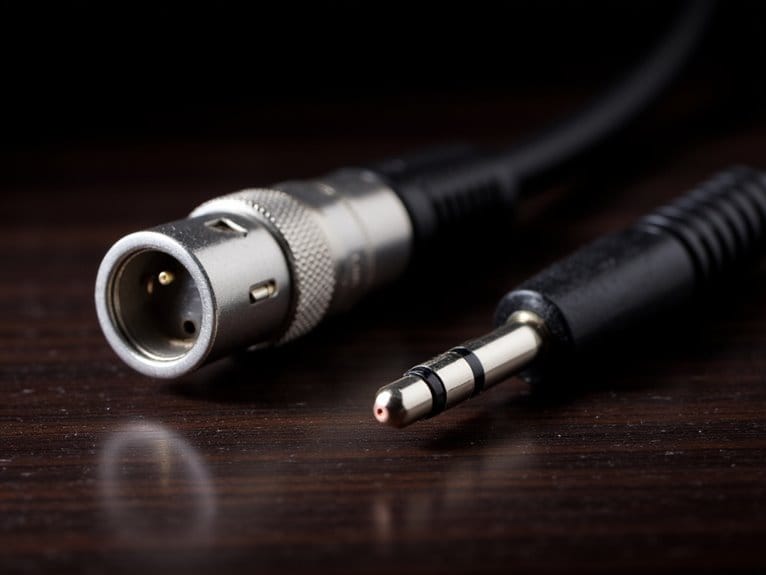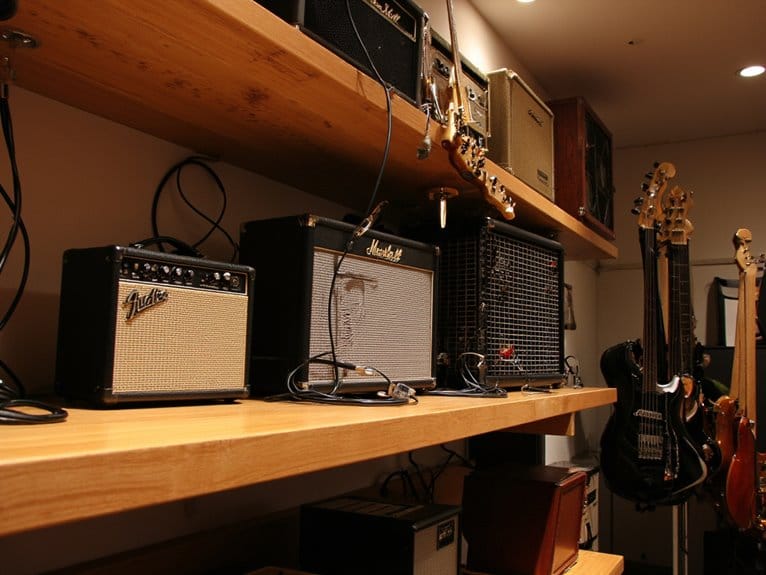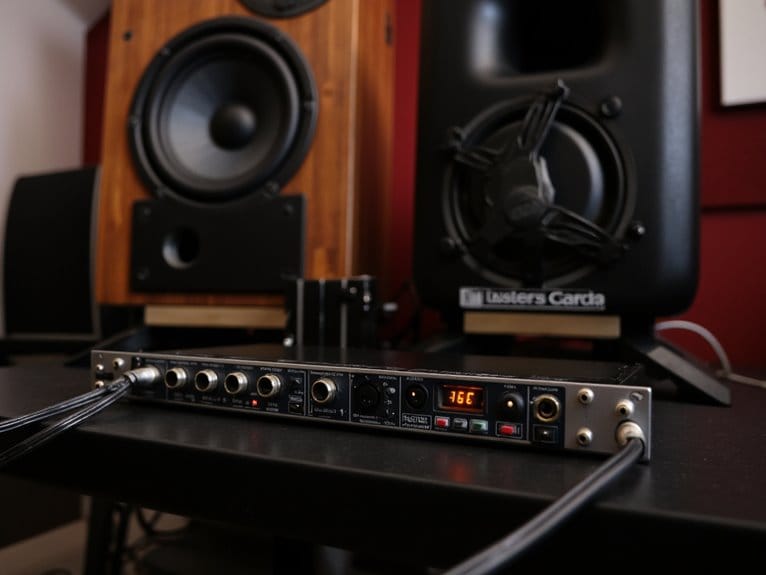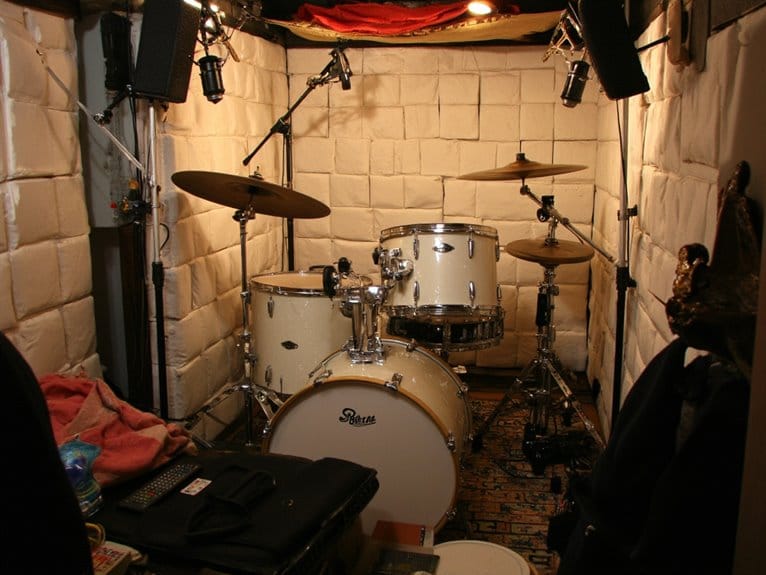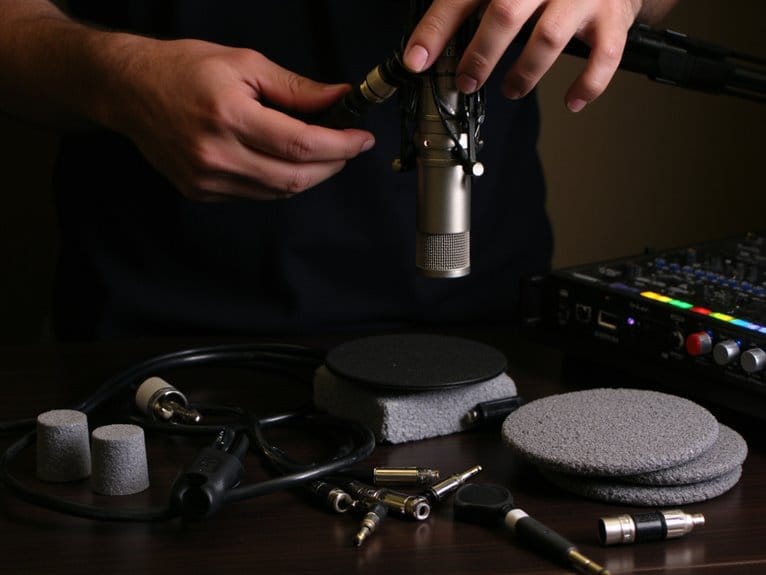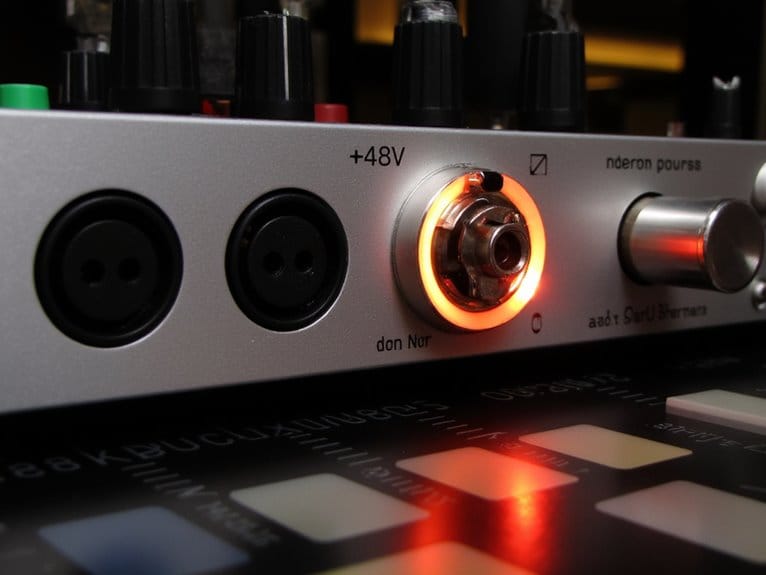Balanced Vs Unbalanced Connections Explained
You’ll find that balanced connections use three conductors—hot, cold, and ground—to cancel interference through differential amplification, while unbalanced connections rely on just one signal wire plus ground, making them vulnerable to noise beyond 25-30 feet. Balanced cables maintain clarity over 100+ feet by rejecting common-mode interference, which is why studios prefer XLR and TRS connectors over unbalanced RCA or TS types. Understanding these distinctions unveils professional-grade audio performance.
We are supported by our audience. When you purchase through links on our site, we may earn an affiliate commission, at no extra cost for you. Learn more.
Notable Insights
- Balanced connections use three conductors (hot, cold, ground) while unbalanced connections use only two (signal, ground).
- Balanced cables actively cancel interference through differential amplification, making them superior for noise rejection in professional environments.
- Unbalanced connections work adequately for short distances under 25-30 feet but deteriorate significantly over longer runs.
- Balanced cables maintain signal clarity over 100+ feet, while unbalanced cables lose quality after 20-30 feet.
- XLR and TRS connectors provide balanced connections; RCA and TS connectors are typically unbalanced for consumer applications.
Understanding the Fundamental Differences Between Connection Types
When you’re setting up audio equipment, whether it’s a home studio or a live performance rig, understanding the fundamental differences between balanced and unbalanced connections can save you from frustrating noise issues and signal degradation problems that’ll leave you scratching your head.
Balanced connections use two signal wires plus ground, creating a system that actively cancels out audio interference through differential amplification, while unbalanced connections rely on just one signal wire and ground.
This distinction becomes essential when you’re dealing with longer cable runs, electromagnetic interference, or professional environments where signal integrity matters most. Magnetic fields from nearby electronic devices can induce unwanted noise into your audio cables, making proper connection choice even more critical.
I’ve found that while unbalanced connections work fine for short distances under 25-30 feet, balanced connections consistently deliver superior performance in challenging situations. It’s important to note that output topology determines how much signal level you’ll lose when connecting balanced equipment to unbalanced inputs.
How Noise Rejection Works in Audio Signal Transmission
Although many audio enthusiasts think noise rejection is some mysterious engineering wizardry, it’s actually a straightforward concept that becomes fascinating once you understand what’s happening inside those cables.
When audio interference strikes, balanced connections employ common-mode rejection to eliminate unwanted signals. The system sends your audio signal through two conductors simultaneously, with one carrying an inverted version of the original signal.
Any noise that affects both conductors equally gets canceled out when the signals recombine at the destination. This superior noise handling capability makes balanced audio the preferred choice for professional setups where audio quality cannot be compromised.
Here’s how effective noise reduction works:
- Paired conductors carry identical signals with opposite polarity
- External interference affects both wires similarly
- Signal inversion at the receiving end cancels common-mode noise
- Electromagnetic and radio frequency interference gets substantially reduced
- Signal integrity remains intact over longer distances
This mechanism explains why professional studios consistently choose balanced connections for critical applications. The twisted wire design in balanced cables further enhances noise reduction by ensuring both conductors receive equal exposure to electromagnetic interference. High-quality audio interfaces with low-noise preamps eliminate background hiss and deliver the clean sound that streamers and content creators demand.
Cable Length Considerations and Signal Integrity
As soon as you start dealing with cable runs longer than a few feet, the fundamental differences between balanced and unbalanced connections become starkly apparent in ways that’ll either make or break your audio quality.
When you’re pushing signals over extended transmission distance, balanced cables maintain their clarity remarkably well, often performing flawlessly at 100 feet or more, while unbalanced connections start deteriorating noticeably after just 20-30 feet.
I’ve seen countless setups where someone assumed their guitar cable would work fine for a 50-foot run, only to discover unwanted noise creeping in. The extra conductor in balanced cables is what makes this extended performance possible by actively rejecting interference that would otherwise compromise your signal.
The cable length consideration isn’t just about convenience—it’s about preserving your signal’s integrity, and balanced connections consistently outperform unbalanced ones as distances increase. Running audio and power cables parallel together creates electromagnetic interference that becomes increasingly problematic with longer cable runs.
Professional recording interfaces with ultralow-noise preamps can maximize the benefits of balanced connections by ensuring the cleanest possible signal path from microphone to recording device.
Connector Types and Equipment Compatibility
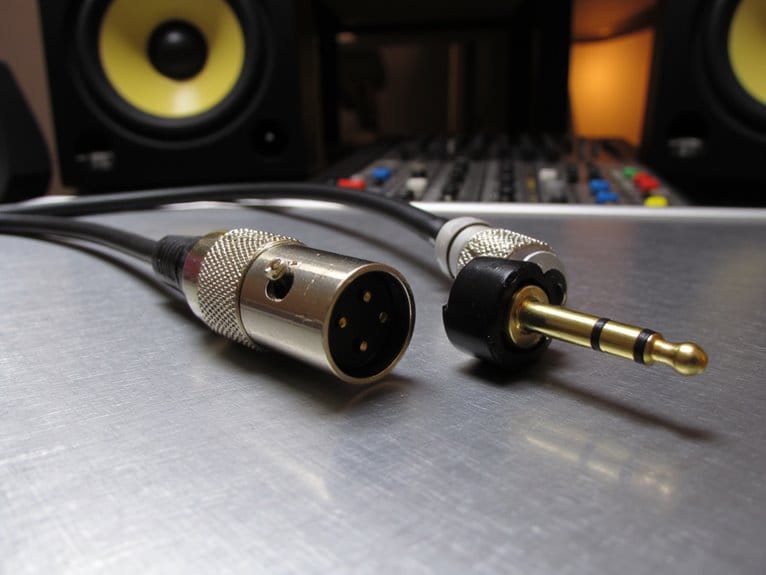
Understanding how cable length affects your signal quality naturally leads us to examine the physical connectors that make these connections possible, and frankly, the connector you choose can be just as important as whether you go balanced or unbalanced.
Different connector types offer varying connector benefits and connection durability:
- XLR connectors provide three-pin balanced connections with excellent locking mechanisms for professional applications
- Quarter-inch TRS jacks handle both balanced mono and unbalanced stereo signals with versatile compatibility
- RCA connectors dominate home audio setups with reliable unbalanced transmission over shorter distances
- 3.5mm TRS connectors serve portable devices and consumer electronics with compact, efficient design
- TS connectors deliver straightforward unbalanced connections for instruments and semi-professional gear
Your equipment compatibility largely determines which connectors you’ll encounter, with professional gear favoring balanced XLR connections while consumer electronics typically use unbalanced RCA or 3.5mm options. The three conductor design in balanced cables enables them to reject interference much more effectively than their unbalanced counterparts.
Quality audio recording requires maintaining proper signal-to-noise ratios throughout your connection chain to achieve professional results. Professional microphones like the J K Pro Earhook deliver impressive 70 dB signal-to-noise ratio for crystal clear audio transmission.
Unbalanced cables function with their ground wire serving as both a signal carrier and shield, which is why they’re most effective within the 15 to 20 foot range for optimal audio quality.
Practical Applications and Common Misconceptions
When you’re deciding between balanced and unbalanced connections in real-world scenarios, I’ve found that the choice often comes down to your specific environment and application rather than following rigid rules.
Professional settings like recording studios, live venues, and film sets demand balanced connections because they handle long cable runs, typically up to 200 feet, while managing substantial electromagnetic interference from lighting and equipment.
Consumer applications in your home studio or personal setup work perfectly fine with unbalanced cables for shorter distances under 25-30 feet. Balanced connections utilize three conductors including ground, hot signal, and cold signal to achieve superior noise rejection compared to unbalanced setups.
The biggest misconception I encounter is assuming you always need opposite-polarity signals for noise rejection—differential inputs actually provide excellent noise challenges mitigation even with single-signal transmission, making signal transmission reliability more about proper implementation than complexity. Higher price tags don’t always correlate with better sound quality since context and proper application matter more than cost.
Frequently Asked Questions
Can I Convert Unbalanced Cables to Balanced Using Adapters or Converters?
You can convert unbalanced cables to balanced using transformers or active converters, though simple adapters won’t create true balanced signals.
For longer cable length runs, I’d recommend transformer-coupled converters since they provide genuine signal inversion and better noise rejection, maintaining signal integrity.
Active converters work well too, but avoid basic cable adapters that just ground the inverted pin—they don’t offer real balanced connection benefits.
Do Balanced Connections Require Special Power or Phantom Power to Work?
Balanced connections don’t require special power to function, though phantom power might be necessary depending on your equipment requirements.
If you’re using condenser microphones or certain active devices, they’ll need phantom power, which your audio interface or mixing board typically provides.
However, most balanced equipment like powered speakers, audio interfaces, and self-powered devices work perfectly without phantom power, relying solely on their internal power sources.
Will Using Balanced Cables Damage Unbalanced Equipment or Cause Compatibility Issues?
You won’t damage your unbalanced equipment using balanced cables, though compatibility concerns exist regarding grounding connections that might cause noise issues rather than equipment safety problems.
I’ve found that while the extra conductor in balanced cables doesn’t provide noise reduction benefits with unbalanced gear, it typically won’t harm anything, making balanced cables versatile options for mixed setups.
Are There Sound Quality Differences Between XLR and TRS Balanced Connections?
When I’ve tested both XLR and TRS balanced connections extensively, you’ll find virtually no sound quality differences between them since both use identical three-conductor wiring for balanced audio transmission.
Cable interference rejection remains equally effective with proper implementation, though XLR’s locking mechanism provides more reliable connections during live performances.
Your audio performance depends more on cable quality, proper shielding, and equipment compatibility than connector type itself.
How Much Do Balanced Cables Typically Cost Compared to Unbalanced Alternatives?
When comparing cost comparison between these cable types, you’ll find balanced cables typically run $20-$50+ while unbalanced alternatives stay under $10-$30.
The cable construction differences explain this gap, since balanced designs require three conductors and premium shielding versus simpler two-conductor unbalanced builds.
I’ve noticed the price differential widens with longer runs, where balanced cables demand better materials for maintaining signal integrity.
On a final note
You’ll find that choosing between balanced and unbalanced connections isn’t rocket science, though it might seem overwhelming at first. If you’re running longer cables or working in electrically noisy environments, balanced connections will serve you better with their superior noise rejection capabilities. For shorter runs and basic home setups, unbalanced cables often work perfectly fine and won’t break your budget while delivering reliable performance.

